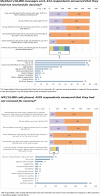Improving Rates of Outpatient Influenza Vaccination Through EHR Portal Messages and Interactive Automated Calls: A Randomized Controlled Trial
- PMID: 29383550
- PMCID: PMC5910339
- DOI: 10.1007/s11606-017-4266-9
Improving Rates of Outpatient Influenza Vaccination Through EHR Portal Messages and Interactive Automated Calls: A Randomized Controlled Trial
Abstract
Background: Patient reminders for influenza vaccination, delivered via electronic health record (EHR) patient portal messages and interactive voice response (IVR) calls, offer an innovative approach to improving patient care.
Objective: To test the effectiveness of portal and IVR outreach in improving rates of influenza vaccination.
Design: Randomized controlled trial of EHR portal messages and IVR calls promoting influenza vaccination.
Participants: Adults with no documented influenza vaccination 2 months after the start of influenza season (2014-2015).
Intervention: Using a factorial design, we assigned 20,000 patients who were active portal users to one of four study arms: (a) receipt of a portal message promoting influenza vaccines, (b) receipt of IVR call with similar content, (c) both a and b, or (d) neither (usual care). We randomized 10,000 non-portal users to receipt of IVR call or usual care. In all intervention arms, information on pneumococcal vaccination was included if the targeted patient was overdue for pneumococcal vaccine.
Main measures: EHR-documented influenza vaccination during the 2014-2015 influenza season, measured April 2015.
Key results: Among portal users, 14.0% (702) of those receiving both portal messages and calls, 13.4% (669) of message recipients, 12.8% (642) of call recipients, and 11.6% (582) of those with usual care received vaccines. On multivariable analysis of portal users, those receiving portal messages alone (OR 1.20, 95% CI 1.06-1.35) or IVR calls alone (OR 1.15 95% CI 1.02-1.30) were more likely than usual care recipients to be vaccinated. Those receiving both messages and calls were also more likely than the usual care group to be vaccinated (ad hoc analysis, using a Bonferroni correction: OR 1.29, 97.5% CI 1.13, 1.48). Among non-portal users, 8.5% of call recipients and 8.6% of usual care recipients received influenza vaccines (p = NS). Pneumococcal vaccination rates showed no significant improvement.
Conclusions: Our outreach achieved a small but significant improvement in influenza vaccination rates. Registration: ClinicalTrials.gov Identifier NCT02266277 ( https://clinicaltrials.gov/ct2/show/NCT02266277 ).
Keywords: electronic health records; influenza vaccination; patient care.
Conflict of interest statement
The authors declare that they do not have a conflict of interest.
Figures
Comment in
-
Capsule Commentary on Cutrona et al., Improving Rates of Outpatient Influenza Vaccination Through EHR Portal Messages and Interactive Automated Calls: a Randomized Controlled Trial.J Gen Intern Med. 2018 May;33(5):745. doi: 10.1007/s11606-018-4384-z. J Gen Intern Med. 2018. PMID: 29532295 Free PMC article. No abstract available.
Similar articles
-
Electronic Health Record Portal Messages and Interactive Voice Response Calls to Improve Rates of Early Season Influenza Vaccination: Randomized Controlled Trial.J Med Internet Res. 2020 Sep 25;22(9):e16373. doi: 10.2196/16373. J Med Internet Res. 2020. PMID: 32975529 Free PMC article. Clinical Trial.
-
Improving Rates of Influenza Vaccination Through Electronic Health Record Portal Messages, Interactive Voice Recognition Calls and Patient-Enabled Electronic Health Record Updates: Protocol for a Randomized Controlled Trial.JMIR Res Protoc. 2016 May 6;5(2):e56. doi: 10.2196/resprot.5478. JMIR Res Protoc. 2016. PMID: 27153752 Free PMC article.
-
Effect of Patient Portal Reminders Sent by a Health Care System on Influenza Vaccination Rates: A Randomized Clinical Trial.JAMA Intern Med. 2020 Jul 1;180(7):962-970. doi: 10.1001/jamainternmed.2020.1602. JAMA Intern Med. 2020. PMID: 32421168 Free PMC article. Clinical Trial.
-
Increasing Influenza Vaccination Rates in People With Chronic Illness.Dtsch Arztebl Int. 2019 Sep 27;116(39):645-652. doi: 10.3238/arztebl.2019.0645. Dtsch Arztebl Int. 2019. PMID: 31617479 Free PMC article.
-
The Contribution of Reminder-Recall to Vaccine Delivery Efforts: A Narrative Review.Acad Pediatr. 2021 May-Jun;21(4S):S17-S23. doi: 10.1016/j.acap.2021.02.016. Acad Pediatr. 2021. PMID: 33958086 Review.
Cited by
-
Impact of Patient Portal Messaging Reminders with Self-Scheduling Option on Influenza Vaccination Rates: a Prospective, Randomized Trial.J Gen Intern Med. 2022 May;37(6):1394-1399. doi: 10.1007/s11606-021-06941-z. Epub 2021 Jun 15. J Gen Intern Med. 2022. PMID: 34131878 Free PMC article. Clinical Trial.
-
Influenza Vaccination Uptake Trends by Age, Race, and Ethnicity in the United States Between 2017 and 2020.J Prim Care Community Health. 2022 Jan-Dec;13:21501319221104917. doi: 10.1177/21501319221104917. J Prim Care Community Health. 2022. PMID: 35678259 Free PMC article. No abstract available.
-
Capsule Commentary on Cutrona et al., Improving Rates of Outpatient Influenza Vaccination Through EHR Portal Messages and Interactive Automated Calls: a Randomized Controlled Trial.J Gen Intern Med. 2018 May;33(5):745. doi: 10.1007/s11606-018-4384-z. J Gen Intern Med. 2018. PMID: 29532295 Free PMC article. No abstract available.
-
Social determinants of health and adult influenza vaccination: a nationwide claims analysis.J Manag Care Spec Pharm. 2022 Feb;28(2):196-205. doi: 10.18553/jmcp.2022.28.2.196. J Manag Care Spec Pharm. 2022. PMID: 35098752 Free PMC article.
-
Uncertainty directed factorial clinical trials.Biostatistics. 2024 Jul 1;25(3):833-851. doi: 10.1093/biostatistics/kxad036. Biostatistics. 2024. PMID: 38330084 Free PMC article.
References
-
- NIH Fact Sheets - Influenza. In: Diseases NIH-NIAID, editor. Research Portfolio Online Reporting Tools (RePORT)2011. Accessed on Jan 9, 2018 at https://report.nih.gov/NIHfactsheets/ViewFactSheet.aspx?csid=133.
-
- National Center for Health Statistics (US. "Health, United States, 2015: with special feature on racial and ethnic health disparities." (2016 May). Report No.: 2016-1232. - PubMed
-
- Kochanek KD, Murphy SL, Xu J. Deaths: Final Data for 2011. National vital statistics reports : from the Centers for Disease Control and Prevention, National Center for Health Statistics, National Vital Statistics System. 2015;63(3):1–120. - PubMed
-
- Kochanek KD, Xu J, Murphy SL, Minino AM, Kung HC. Deaths: final data for 2009. National vital statistics reports : from the Centers for Disease Control and Prevention, National Center for Health Statistics, National Vital Statistics System. 2011;60(3):1–116. - PubMed
Publication types
MeSH terms
Substances
Associated data
LinkOut - more resources
Full Text Sources
Other Literature Sources
Medical
Miscellaneous



